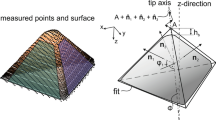Abstract
For blood perfusion monitoring, laser speckle contrast (LSC) imaging is a recent non-contact technique that has the characteristic of delivering noise-like speckled images. To exploit LSC images for quantitative physiological measurements, we developed an approach that implements controlled spatial averaging to reduce the detrimental impact of the noise and improve measurement sensitivity. By this approach, spatial resolution and measurement sensitivity can be traded-off in a flexible way depending on the quantitative prospect of the study. As an application, detectability of the cardiac activity from LSC images of forearm using power spectrum analysis is studied through the construction of spatial activity maps offering a window on the blood flow perfusion and its regional distribution. Comparisons with results obtained with signals of laser Doppler flowmetry probes are performed.







Similar content being viewed by others
References
Aizu Y, Asakura T (1991) Bio-speckle phenomena and their application to the evaluation of blood flow. Opt Laser Technol 23:205–219
Cai H, Rohman H, Larsson SE, Öberg PÅ (1996) Laser Doppler flowmetry: characteristics of a modified single-fibre technique. Med Biol Eng Comput 34(1):2–8
de Mul F, Blaauw J, Aarnoudse JG, Smit A, Rakhorst G (2005) A model for post-occlusive reactive hyperemia as measured with laser-Doppler perfusion monitoring. IEEE Trans Biomed Eng 52:184–190
Draijer M, Hondebrink E, Leeuwen T, Steenbergen W (2009) Review of laser speckle contrast techniques for visualizing tissue perfusion. Lasers Med Sci 24:639–651
Humeau A, Steenbergen W, Nilsson H, Strömberg T (2007) Laser Doppler perfusion monitoring and imaging: novel approaches. Med Biol Eng Comput 45(5):421–435
Humeau A, Buard B, Mahé G, Chapeau-Blondeau F, Rousseau D, Abraham P (2010) Multifractal analysis of heart rate variability and laser Doppler flowmetry fluctuations: comparison of results from different numerical methods. Phys Med Biol 55(20):6279–6297
Mahé G, Rousseau P, Durand S, Bricq S, Leftheriotis G, Abraham P (2011) Laser speckle contrast imaging accurately measures blood flow over moving skin surfaces. Microvasc Res 81:183–188
Mahé G, Haj-Yassin F, Rousseau P, Humeau A, Durand S, Leftheriotis G, Abraham P (2011) Distance between laser head and skin does not influence skin blood flow values recorded by laser speckle imaging. Microvasc Res 82(3):439–442
Mahé G, Humeau-Heurtier A, Durand S, Leftheriotis G, Abraham P (2012) Assessment of skin microvascular function and dysfunction with laser speckle contrast imaging. Circ Cardiovasc Imaging 5(1):155–163
Nilsson G, Tenland T, Oberg P (1980) A new instrument for continuous measurement of tissue blood flow by light beating spectroscopy. IEEE Trans Biomed Eng 27:12–19
O’Doherty J, McNamara P, Clancy N, Enfield J, Leahy M (2009) Comparison of instruments for investigation of microcirculatory blood flow and red blood flow and red blood cell concentration. J Biomed Opt 14:034025
Rousseau P, Mahé G, Fromy B, Ducluzeau PH, Saumet JL, Abraham P (2009) Axon-reflex cutaneous vasodilatation is impaired in type 2 diabetic patients receiving chronic low-dose aspirin. Microvasc Res 78(2):218–223
Rousseau P, Mahé G, Haj-Yassin F, Durand S, Humeau A, Leftheriotis G, Abraham P (2011) Increasing the “region of interest” and “time of interest”, both reduce the variability of blood flow measurements using laser speckle contrast imaging. Microvasc Res 82:1–4
Roustit M, Blaise S, Millet C, Cracowski JL (2010) Reproducibility and methodological issues of skin post-occlusive and thermal hyperemia assessed by single-point laser Doppler flowmetry. Microvasc Res 79:102–108
Roustit M, Millet C, Blaise S, Dufournet B, Cracowski JL (2010) Excellent reproducibility of laser speckle contrast imaging to assess skin microvascular reactivity. Microvasc Res 80:505–511
Roustit M, Blaise S, Millet C, Cracowski JL (2011) Impaired transient vasodilation and increased vasoconstriction to digital local cooling in primary Raynaud’s phenomenon. Am J Physiol Heart Circ Physiol 301(2):324–330
Sheppard LW, Vuksanović V, McClintock PV, Stefanovska A (2011) Oscillatory dynamics of vasoconstriction and vasodilation identified by time-localized phase coherence. Phys Med Biol 56(12):3583–3601
Shiogai Y, Stefanovska A, McClintock PVE (2010) Nonlinear dynamics of cardiovascular ageing. Phys Rep 488:51–110
Stefanovska A, Lunchinsky D, Mc Clintock P (2001) Modelling couplings among the oscillators of the cardiovascular system. Physiol Meas 22:551–564
Stefanovska A, Lotric MB, Strle S, Haken H (2001) The cardiovascular system as coupled oscillators? Physiol Meas 22:535–550
Stern MD (1975) In vivo evaluation of microcirculation by coherent light scattering. Nature 254:56–58
Stewart C, Frank R, Forrester K, Tulip J, Lindsay R, Bray R (2005) Comparison of two laser-based methods for determination of burn scar perfusion: laser Doppler versus laser speckle imaging. Burns 31:744–752
Author information
Authors and Affiliations
Corresponding author
Rights and permissions
About this article
Cite this article
Bricq, S., Mahé, G., Rousseau, D. et al. Assessing spatial resolution versus sensitivity from laser speckle contrast imaging: application to frequency analysis. Med Biol Eng Comput 50, 1017–1023 (2012). https://doi.org/10.1007/s11517-012-0919-3
Received:
Accepted:
Published:
Issue Date:
DOI: https://doi.org/10.1007/s11517-012-0919-3




